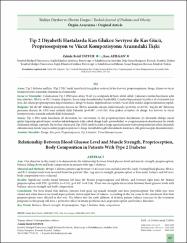| dc.contributor.author | Tayfur, Zahide Betül | |
| dc.contributor.author | Atılgan, Esra | |
| dc.date.accessioned | 2022-03-03T13:14:26Z | |
| dc.date.available | 2022-03-03T13:14:26Z | |
| dc.date.issued | 2020 | en_US |
| dc.identifier.citation | Tayfur, Z. B. ve Atılgan, E. (2020). Tip 2 diyabetli hastalarda kan glukoz seviyesi ile kas gücü, propriosepsiyon ve vücut kompozisyonu arasındaki ilişki. Türkiye Diyabet ve Obezite Dergisi, 4(3), 207-213. https://doi.org/10.25048/tudod.732903 | en_US |
| dc.identifier.issn | 2587-0335 | |
| dc.identifier.issn | 2587-0572 | |
| dc.identifier.uri | https://doi.org/10.25048/tudod.732903 | |
| dc.identifier.uri | https://hdl.handle.net/20.500.12511/9090 | |
| dc.description.abstract | Amaç: Tip 2 diabetes mellitus (Tip 2 DM) tanılı hastalarda kan glukoz seviyesi ile kas kuvveti, propriosepsiyon, denge, düşme ve vücutkompozisyonu arasındaki ilişkinin incelenmesidir.Gereç ve Yöntemler: Çalışmamıza Tip 2 DM tanısı almış 35-65 yaş aralığında 40 hasta dahil edildi. Çalışmaya katılan hastaların açlıkkan şekerleri, HbA1c ve B12 vitamin değerleri, hasta takip dosyalarından kaydedildi. Çalışma kapsamında hastalara alt ekstremite kastesti, diz eklemi propriosepsiyon değerlendirmesi, denge ve düşme değerlendirme testleri, vücut kütle indeksi değerlendirmeleri yapıldı.Bulgular: Sol diz 60° fleksiyon pozisyon duyusu ile HbA1c arasında anlamlı ilişki bulundu (p=0,026, rs=0,352). Sağ diz 60° fleksiyonpozisyon duyusu ile APG arası anlamlı ilişki bulundu (p=0,047, rs=0,316). Kan glukoz seviyeleri ile denge, kas kuvveti ve vücutkompozisyonu arasında anlamlı ilişki bulunmadı.Sonuç: Tip 2 DM tanılı hastaların alt ekstremite kas kuvvetinin ve diz propriosepsiyon duyularının iyi durumda olduğu ancakgözler kapatılıp görsel input ortadan kaldırıldığında daha çabuk denge kaybı gösterdikleri ve propriosepsiyon duyularının bu yöndeetkilenmiş olduğu saptandı. Bu verilere dayanarak Tip 2 DM tanılı hastalara denge egzersizlerinin tedavi programlarına erken dönemdeeklenmesinin ileride yaşayacakları propriosepsiyon ve denge bozuklukları gibi durumlarda koruyucu etki göstereceğini düşünmekteyiz. | en_US |
| dc.description.abstract | Aim: Our objective in this study is to demonstrate the relationship between blood glucose level and muscle strength, proprioception, balance-falling down and body composition in patients with type 2 diabetes. Material and Methods: 40 type 2 diabetic patients age between 35-65 years were included into the study. Fasting blood glucose, HbA1c and B12 vitamin levels were recorded from the patients’ files. Leg muscle strength, proprioception of knee joint, balance and fall tests, body composition were evaluated. Results: Significant results found between left knee 60° flexion propcioception and HbA1c and between right knee 60° flexion propcioception with FPG (p=0.026, rs=0.352, p=0.047 rs=0.316). There was no significant relation between blood glucose levels with balance, muscle strength and body composition. Conclusion: We have found that diabetic patients have good leg muscle strength and knee proprioception, but while eyes were closed and when there is no visual input patients shown rapid lose of balance. According to this we came to the conclusion that their proprioceptions were affected in this way. We believe that the early addition of diabetic patient balance exercises to the treatment programs in this group will have a protective effect on future problems such as proprioception and balance disorders. | en_US |
| dc.language.iso | tur | en_US |
| dc.rights | info:eu-repo/semantics/openAccess | en_US |
| dc.subject | Denge | en_US |
| dc.subject | Kas Gücü | en_US |
| dc.subject | Propriosepsiyon | en_US |
| dc.subject | Tip 2 Diyabet | en_US |
| dc.subject | Vücut Kompozisyonu | en_US |
| dc.subject | Balance | en_US |
| dc.subject | Muscle Strength | en_US |
| dc.subject | Proprioception | en_US |
| dc.subject | Type 2 Diabetes | en_US |
| dc.subject | Body Composition | en_US |
| dc.title | Tip 2 diyabetli hastalarda kan glukoz seviyesi ile kas gücü, propriosepsiyon ve vücut kompozisyonu arasındaki ilişki | en_US |
| dc.title.alternative | Relationship between blood glucose level and muscle strength, proprioception, body composition in patients with type 2 diabetes | en_US |
| dc.type | article | en_US |
| dc.relation.ispartof | Türkiye Diyabet ve Obezite Dergisi | en_US |
| dc.department | İstanbul Medipol Üniversitesi, Sağlık Bilimleri Enstitüsü, Fizyoterapi ve Rehabilitasyon Ana Bilim Dalı | en_US |
| dc.department | İstanbul Medipol Üniversitesi, Sağlık Bilimleri Fakültesi, Fizyoterapi ve Rehabilitasyon Bölümü | en_US |
| dc.authorid | 0000-0002-7403-1286 | en_US |
| dc.authorid | 0000-0002-6381-5982 | en_US |
| dc.identifier.volume | 4 | en_US |
| dc.identifier.issue | 3 | en_US |
| dc.identifier.startpage | 207 | en_US |
| dc.identifier.endpage | 213 | en_US |
| dc.relation.publicationcategory | Makale - Ulusal Hakemli Dergi - Kurum Öğretim Elemanı | en_US |
| dc.identifier.doi | 10.25048/tudod.732903 | en_US |
| dc.institutionauthor | Tayfur, Zahide Betül | |
| dc.institutionauthor | Atılgan, Esra | |
| dc.identifier.trdizinid | TkRReU1qWTRPQT09 | en_US |


















